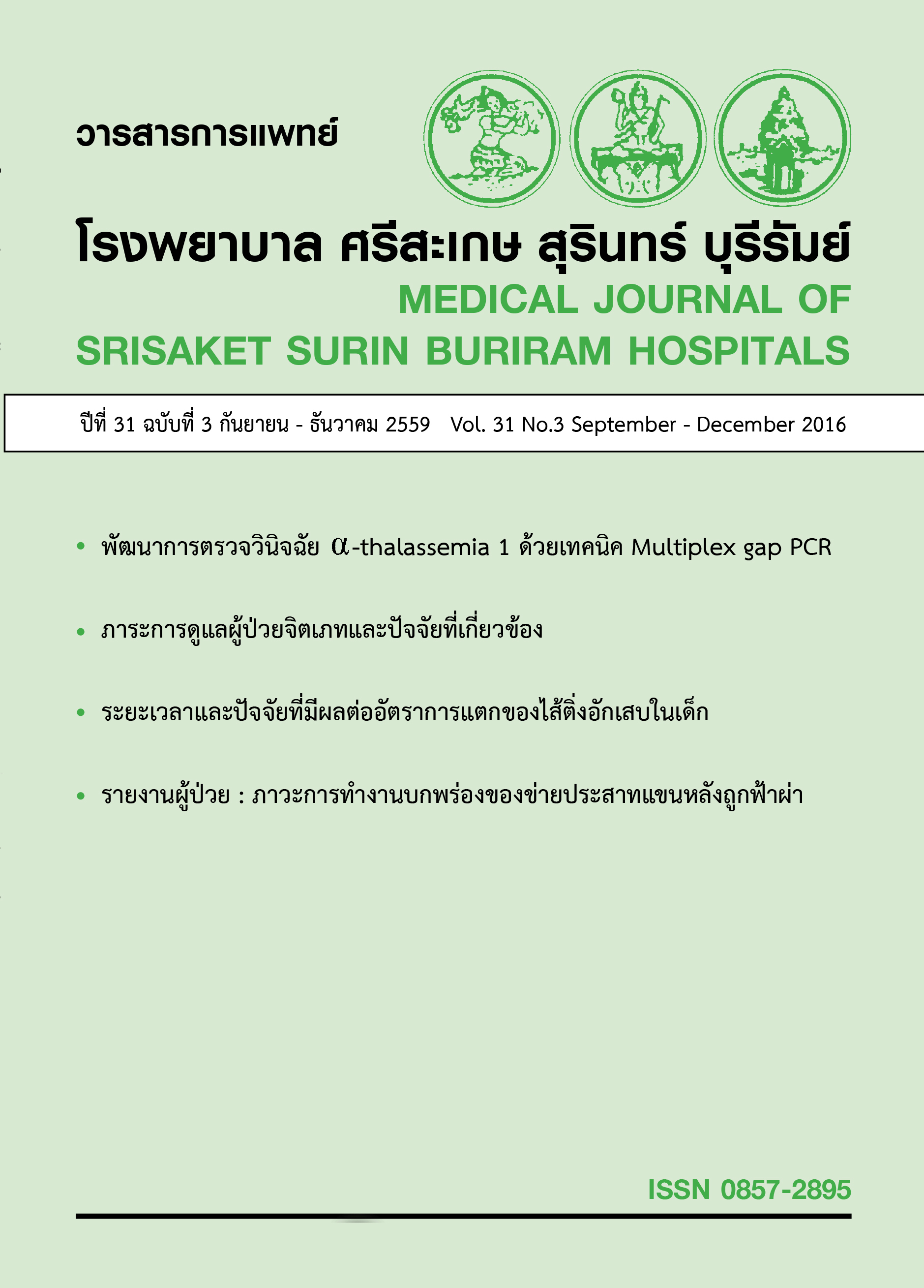ระยะเวลาและปัจจัยที่มีผลต่ออัตราการแตกของไส้ติ่งอักเสบในเด็ก
Main Article Content
บทคัดย่อ
บทนำ: ไส้ติ่งอักเสบในเด็กมีอัตราการแตกที่สูง ซึ่งพบว่าแปรตามระยะเวลาการดำเนินโรค
วัตถุประสงค์: เพื่อหาผลของระยะเวลาการดำเนินโรคและความสัมพันธ์ของปัจจัยต่ออัตราการแตกของไส้ติ่งอักเสบในเด็ก
รูปแบบการวิจัย: การศึกษาติดตามแบบย้อนหลังในเด็กที่มีภาวะฉุกเฉินทางช่องท้อง
สถานที่: โรงพยาบาลศรีสะเกษ
วิธีการวิจัย: ใช้ข้อมูลจากเวชระเบียนและผลตรวจทางพยาธิวิทยา หาอัตราการแตกของไส้ติ่งอักเสบ โดยใช้การวิเคราะห์การอยู่รอดแบบตารางชีพ และหาปัจจัยที่สามารถทำนายการแตก โดยการวิเคราะห์ถดถอยโลจิสติก
ผลการวิจัย: กลุ่มเด็กที่เป็นไส้ติ่งอักเสบตั้งแต่พ.ศ.2557-2558 จำนวน 150 คนอายุเฉลี่ย 9.6 ปีพบ อัตราไส้ติ่งอักเสบแตก ร้อยละ 22โดยระยะเวลาการดำเนินโรคที่ 36-48 ชั่วโมง เป็นช่วงเวลาที่มีอัตราเสี่ยงต่อการแตกของไส้ติ่งอักเสบต่ำสุดโดยมีโอกาสที่ไส้ติ่งอักเสบจะแตก เท่ากับร้อยละ 5 ส่วนระยะเวลาการดำเนินโรคที่ 108-120 ชั่วโมง เป็นช่วงเวลาที่มีอัตรา เสี่ยงต่อการแตกสูงสุดถึง ร้อยละ 8 ต่อชั่วโมงและมีโอกาสแตก ร้อยละ 67 ค่ามัธยฐาน การอยู่รอดเท่ากับ68.13 ชั่วโมงโดยปัจจัยที่ร่วมกันทำนายการแตกของไส้ติ่งอักเสบคือ การรับประทานยาปฏิชีวนะมาก่อน, ความล่าช้าจากผู้ป่วย และอุณหภูมิร่างกาย โดย เพิ่มโอกาสเสี่ยงเป็น 4.18 เท่า (95% CI: 1.65-10.59), 1.03 เท่าต่อชั่วโมง (95% CI: 1.01-1.05) และ 3.54 เท่าต่อองศาเซลเซียส (95% CI: 1.95-6.43) ตามลำดับ
สรุป: ควรเฝ้าระวังผู้ป่วยที่มีระยะเวลาการดำเนินโรคมากกว่า 108 ชั่วโมงอย่างใกล้ชิด และ ควรส่งเสริมความรู้ความเข้าใจแก่ประชาชนเพื่อลดความล่าช้าจากผู้ป่วย ตลอดจน สนับสนุนให้ใช้ยาปฏิชีวนะอย่างสมเหตุสมผล
Article Details
References
2. Martin AE, Vollman D, Adler B, Caniano DA. CT scans may not reduce the negative appendectomy rate in children. J Pediatr Surg 2004;39(6):886-90
3. Alvarado. A practical score for the early diagnosis of acute appendicitis. Ann Emerg Med 1986;15(5):557-64.
4. Samuel M. Pediatric appendicitis score. J Pediatr Surg 2002;37(6): 877-81.
5. Tantemsapya N, Laohapensang M, Udom- punturak S. Validation of Clinical Scoring System in the Primary Care Acute Appendicitis. Siriraj Med J 2005;57(11):481-4.
6. Chong CF, Adi Ml, Thien A, et al. Development of the RIPASA score: a new appendicitis scoring system for the diagnosis of acute appendicitis. Singapore Med J 2010;51:220-5.
7. Chong CF, Thien A, Mackie AJ, Tin AS, Tripathi S, Ahmad MA, Tan LT, Ang SH, Telisinghe PU. Comparison of RIPASA and Alvarado scores for the diagnosis of acute appendicitis. Singapore Med J 2011;52(5):340-5.
8. Malla BR, Batajoo FI. Comparison of Tzanakis score vs Alvarado score in the effective diagnosis of acute appendicitis. Kathmandu Univ Med J (KUMJ) 2014;12(45):48-50.
9. Rafiq MS, Khan MM, Khan A, Jan FI. Receiver operator characteristic curve analysis of Lintula score for reduction of negative appendectomies in adults. J Coll Physicians Surg Pak 2015;25(2):100-3.
10. Yap TL, Chen Y, Low WW, Ong CC, Nah SA, Jacobsen AS, Shen L, Low Y. A new 2-step risk-stratification clinical score for suspected appendicitis in children. J Pediatr Surg 2015;50(12):2051-5.
11. Bealer JF, Colgin M. S100A8/A9: a potential new diagnostic aid for acute appendicitis. Acad Emerg Med 2010;17(3):333-6.
12 Benito J, Acedo Y, Medrano L, Barcena E, Garay RP, Arri EA. Usefulness of new and traditional serum biomarkers in children with suspected appendicitis. Am J Emerg Med 2016 May;34(5):871-6.
13. Sevinp MM, Kinaci E, fakar E, Bayrak S, Ozakay A, Aren A, Sari S. Diagnostic value of basic laboratory parameters for simple and perforated acute appendicitis: an analysis of 3392 cases. Ulus Travma AcilCerrahi Derg 2016;22(2):155-62.
14. Bonadio W, Peloquin P, Brazg J, Schein- bach I, Saunders J, Okpalaji C, Flomel P. Appendicitis in preschool aged children: Regression analysis of factors associated with perforation outcome. J Pediatr Surg 2015;50(9):1569-73.
15. Bickell NA, Aufses AH Jr, Rojas M, Bodian C. Flow time affects the risk of rupture in appendicitis. J Am Coll Surg 2006;202(3):401-6.
16. Kim M, Kim SJ, Cho HJ. Effect of surgical timing and outcomes for appendicitis severity. Ann Surg Treat Res 2016;91(2):85-9.
17. van den Bogaard VA, Euser SM, van der Ploeg T, de Korte N, Sanders DG, de Winter D, Vergroesen D, van Groningen K, de Winter p. Diagnosing perforated appendicitis in pediatric patients: a new model. J Ped Surg 2016;51(3):444-8.
18. Papaziogas B, Tsiaousis P, Koutelidakis I, Giakoustidis A, Atmatzidis S, Atmatzidis K. Effect of time on risk of perforation in acute appendicitis. Acta Chir Belg 2009; 109(l):75-80.
19. Burjonrappa S, Rachel D. Pediatric appendectomy: optimal surgical timing and risk assessment. Am Surg 2014;80(5):496-9.
20. Furuya T, Inoue M, Sugito K, Goto S, Kawashima H, Kaneda H, MasukoT, Ohashi K, Ikeda T, Koshinaga T. Effectiveness of Interval Appendectomy After Conservative Treatment of Pediatric Ruptured Appendicitis with Abscess. Indian J Surg 2015; 77(Suppl 3):1041-4.
21. Caruso AM, Pane A, Garau R, Atzori p, Podda M, Casuccio A, Mascia L. Acute appendicitis in children: not only surgical treatment. J Pediatr Surg 2016;S0022- 3468(16)30277-9.
22. Gurien LA, Wyrick DL, Smith SD, Dassinger MS. Optimal timing of appendectomy in the pediatric population. J Surg Res 2016;202(1):126-31.
23. Nomura O, Ishiguro A, Maekawa T, Nagai A, Kuroda T, Sakai H. Antibiotic administration can be an independent risk factor for therapeutic delay of pediatric acute appendicitis. Pediatr Emerg Care 2012 Aug;28(8):792-5.

